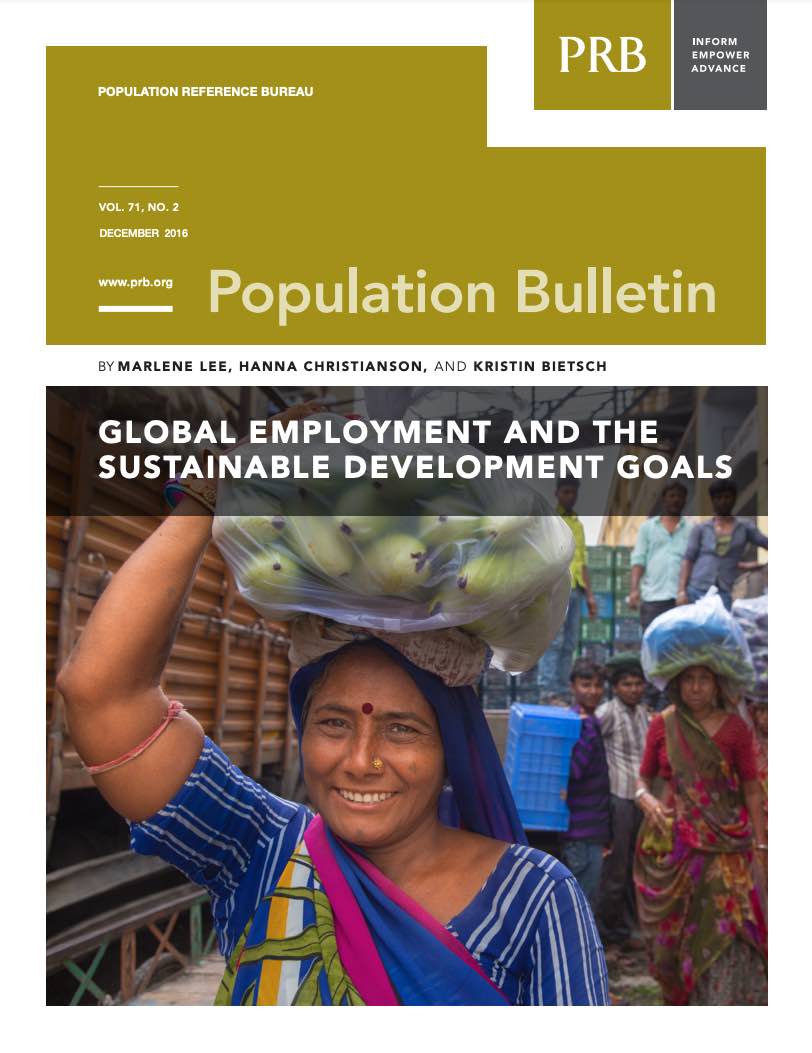
Global Employment and the Sustainable Development Goals
Product: Population Bulletin, vol. 71, no. 2
Authors: Marlene Lee Hanna Christianson Kristin Bietsch
Date: April 18, 2017
In September 2015, the 193 member states of the United Nations adopted a broad universal development agenda, the Sustainable Development Goals (SDGs). These goals will shape countries’ planning and spending over the next 15 years. The SDGs include commitments to tackle poverty, inequality, and environmental challenges.
Demography will have a bearing on whether many of these goals are achieved, particularly Goal 8: Full and productive employment and decent work for all. Factors critical to employment growth emerge throughout the goals, including creation of economic opportunities and basic preparation of a healthy and educated workforce.
This Population Bulletin, written by staff of PRB’s International Programs, examines the demographic challenges associated with achieving full and productive employment and decent work for all across regions and countries. Here are a few highlights from the Bulletin:
General Demographic Trends
- With generally declining fertility rates and fewer children born each year, growth of the world’s working-age population has slowed. After more than tripling between 1950 and 2000 to 4.8 billion, the world added only 1 billion people of working-age between 2000 and 2015, and only 700 million will be added between 2015 and 2030.
- Sub-Saharan Africa (SSA) remains in a period of rapidly growing youth cohorts, meaning the region’s working-age population will continue to grow rapidly. According to economist David Lam, SSA needs to generate about 1 million new jobs per month to keep employment rates stable and will need to generate almost 2 million jobs per month by 2030.
- Currently, China and India have by far the largest labor forces in the world, totaling 806.5 million and 497 million respectively. the United States is a distant third at 161 million. China now has a declining share as a result of three decades with a one-child policy until 2015.
Youth Employment
- In the last two decades, the number of economically active youth declined substantially (by about 30 million) even while the youth population has grown. The good news is that young people’s increased secondary and tertiary school enrollment contributed to these trends.
- Even so, youth unemployment remains a critical challenge. In the Middle East and North Africa (MENA), for example, the youth unemployment rate was 27 percent in 2013, twice the average world rate and the highest of any region, according to the International Labor Organization.
- In many higher-income countries, particularly in Europe and Latin America, substantial employment barriers for youth with lower education creates high levels of youth who are “not in employment, education, or training (NEET). The highest youth NEET rates among Organization for Economic Cooperation and Development countries are in Italy, Greece, and Turkey.
Gender Gaps in Employment
- Gender gaps in labor force participation and employment status continue to disadvantage women around the world, despite recent gains in most regions.
- Globally, men have a 60 percent share of paid work compared to 40 percent for women.
- Gender gaps in wages, working hours, industrial sectors, and occupations stem partly from gender inequalities in family responsibilities, with childbearing and unpaid care as well as other household work using more of women’s time then men’s.
- Childbearing also plays a role, given that each additional birth keeps a woman out of the labor force for an average of two years. Falling fertility rates hold out the possibility that women will devote less time to childcare.
- In 2015, women represented approximately 50 percent of the world’s population age 15 or older but 40 percent of the world’s employed.
- Women constituted 23 percent of the world’s employers; 33 percent of own-account workers (self-employed without employees); and 63 percent of unpaid family workers.
Child Labor
- Rates of child labor have shrunk by about one-third since 2000, down 40 percent for girls and 25 percent for boys, but much work remains to be done to address this vulnerability.
- Nearly 11 percent of children ages 5 to 17 globally (168 million) are engaged in child labor. This works out to almost 100 million boys and 68 million girls.
- Child labor is heavily concentrated in the 5-to-11 age group, accounting for 44 percent of all child laborers. The 12-to-14 age group and the 15-to-17 age group each account for 28 percent.
- Approximately 51 percent of child labor can be defined as hazardous.
- Child labor is most prevalent in SSA, where one in five children between ages 5 and 17 are child laborers.
People With Disabilities
- The one in seven people with some kind of disability face barriers, not just to employment but also to the workplace. Their employment rates remain well below rate for the general population in both low-income and high-income countries.
- In low-income countries on average, 59 percent of working-age men with disabilities are employed, compared with 71 percent of working-age men without disabilities. The comparable spread for women is 20 percent and 31 percent, respectively.
- In high-income countries on average, 36 percent of working-age men with disabilities are employed, compared with 71 percent of working-age men without disabilities. The comparable spread for women is 20 percent and 31 percent, respectively.
Older Workers
- Older workers’ participation in the labor force is generally related to the level of incentives for labor force withdrawal in a country. More extensive government social security systems (primarily in high-income countries) tend to have fewer people remaining in the labor force in older age.

 ">
">